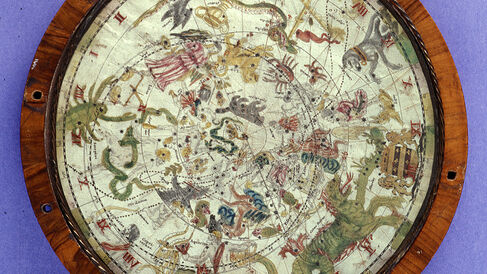An Immobile Globe

The 'English Globe' is a rare example of an immobile globe, whose sphere does not rotate but is fixed in place over a planisphere. Its fixed position allows complex calculations to be performed more easily than with a turning sphere.
Roger Palmer(1634-1705), Earl of Castlemaine and Cambridge-educated son of Sir James Palmer, collaborated with Joseph Moxon (1627-1691), son and apprentice of printer James Moxon, in 1679 to produce an instrument that they named the 'English Globe'. Three examples of English Globes are preserved at the University of Cambridge in the University Library, Pembroke College, and the Whipple Museum (on loan from Trinity College, Cambridge).
Hermann von Helmholtz (1821-1894) was amongst the last of the great polymaths. He made significant contributions to all of the sciences as well as to philosophy and the arts, his enormous contribution to acoustics being just one of his many outputs. The Whipple's collection contains several items relating to his work, including his apparatus for the synthesis of sound and his iconic resonators.
Early life
Helmholtz was born in 1821 in Potsdam, Prussia, the only son of a school teacher. He had wanted to study physics but his father could not afford to sponsor him in that costly pursuit. However, the Prussian government offered bursaries for the study of medicine for anyone who would sign up for military service and so Helmholtz enrolled at a medical institute in Berlin after which he was assigned a post with a guards regiment in Potsdam. As a promising medical doctor he was given space to set up his own laboratory where he began a series of important experiments in optics and nerve impulses. In addition, and despite a full-time position as an army surgeon, he was able to devote attention to establishing a firm mathematical basis for the principle of the conservation of energy. The brilliance of Helmholtz's work led to a cancellation of his remaining years of army service and to his appointment as Professor of physiology at Koenigsberg. He then quit medicine and focused exclusively on physiology and physics.
The English Globe as a Ptolemaic instrument
The English Globe is the only known immobile globe, its sphere fixed in position on a pedestal, rather than being held in a meridian ring that could be rotated in a horizon band (Image 1). The English Globe constitutes the only known truly Ptolemaic globe, representing the Earth as stationary rather than moving, as it is in the Copernican system. The Earl of Castlemaine did not believe in a geocentric universe but constructed the globe in this way to make it more practically useful: the presence of lead shot, shown in image 2, shows that this sphere was originally intended for a turning globe. As described by Castlemaine in The English Globe, published in 1679, the globe's novel construction meant that it could be used to solve many conventional practical globe problems.
Outdoor globe use
The sphere of the English Globe was set above a planisphere appropriate for the latitude of London and was fixed with the south of England uppermost, parallel with the horizon. This meant that when composed (that is, levelled and orientated north-south in the Sun's rays) the English Globe was an exact replica of the Earth itself. Most of the English Globe's many functions, as described in Castlemaine's publication, required the globe to be used outside on a fine day so that the rays of the Sun fell on the sphere as they did on the Earth itself. Many of the English Globe's functions pertained to dialling, the art of constructing and using sundials, which became increasingly popular in the course of the 17th century.
Production of the English Globe
Castlemaine designed the English Globe after seeing one of Moxon's pocket globes and Moxon executed Castlemaine's design, from cartography to instrument construction. Moxon used existing materials to craft the unique instrument, updating existing plates for the cartography and then applying the printed gores to a blank sphere originally intended for a turning globe. We know that this is the case because a loose bag of lead shot, used to balance spheres to allow a steady turn, is visible in x-rays of the instrument that were taken during conservation work in the 1990s (Image 2).
Moxon also brought his own interests as a printer to bear on the English Globe, using different typescripts to distinguish old and new names for the same localities. For instance, archaic names for localities were inscribed in Gothic type. Thus, Sumatra and Zeilan (Sri Lanka) were also labelled 'Taprobane' as they had both previously been known (Image 3).
This article is based on the work of Kemal de Soysa, 'On the use of the globe: The Earl of Castlemaine's English Globe and Restoration Mathematics', submitted for the MPhil Degree, 2000.
Katie Taylor
Katie Taylor, 'An immobile globe, designed by the Earl of Castlemaine and Joseph Moxon', Explore Whipple Collections, Whipple Museum of the History of Science, University of Cambridge, 2009.
